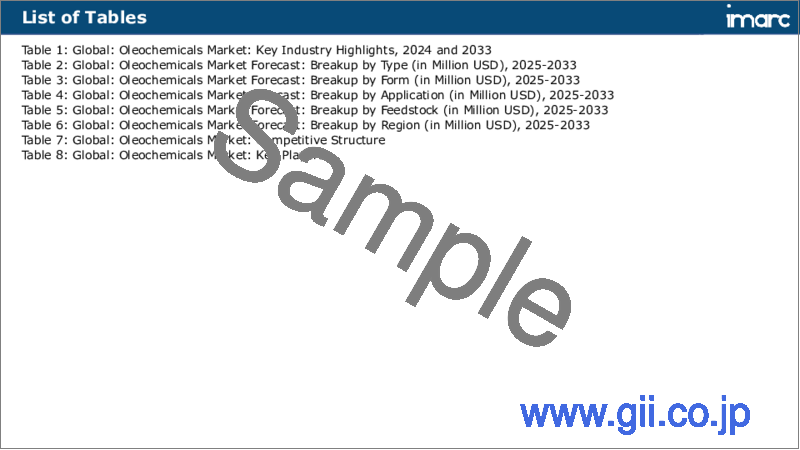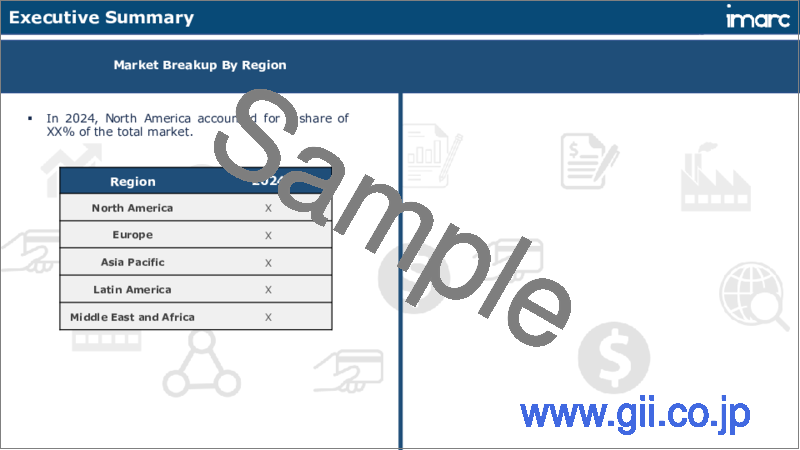|
|
市場調査レポート
商品コード
1609768
日本の軟包装市場レポート:製品タイプ、原材料料、印刷技術、用途、地域別、2025年~2033年Japan Flexible Packaging Market Report by Product Type, Raw Material, Printing Technology, Application, and Region 2025-2033 |
||||||
カスタマイズ可能
|
|||||||
| 日本の軟包装市場レポート:製品タイプ、原材料料、印刷技術、用途、地域別、2025年~2033年 |
|
出版日: 2024年12月05日
発行: IMARC
ページ情報: 英文 122 Pages
納期: 5~7営業日
|
- 全表示
- 概要
- 目次
日本の軟包装市場の市場規模は2024年に85億米ドルに達しました。IMARC Groupは、2025年から2033年にかけての成長率(CAGR)は6.2%で、2033年には147億米ドルに達すると予測しています。便利で持ち運びに便利な、ポーションコントロールされた製品への需要など、消費者の嗜好の変化がフレキシブルパッケージングソリューションへのニーズを煽り、市場を牽引しています。
本レポートで扱う主な質問
- 日本の軟包装市場はこれまでどのように推移し、今後どのように推移するか?
- COVID-19が日本の軟包装市場に与えた影響は?
- 日本の軟包装市場の製品タイプ別の内訳は?
- 日本の軟包装市場の原材料別の内訳は?
- 日本の軟包装市場の印刷技術別の内訳は?
- 日本の軟包装市場の用途別の内訳は?
- 日本の軟包装市場のバリューチェーンにはどのような段階があるのか?
- 日本の軟包装における主な促進要因と課題は?
- 日本の軟包装市場の構造と主要プレーヤーは?
- 日本の軟包装市場における競合の程度は?
目次
第1章 序文
第2章 調査範囲と調査手法
- 調査の目的
- ステークホルダー
- データソース
- 市場推定
- 調査手法
第3章 エグゼクティブサマリー
第4章 日本の軟包装市場:イントロダクション
- 概要
- 市場力学
- 業界動向
- 競合情報
第5章 日本の軟包装市場情勢
- 過去および現在の市場動向(2019年~2024年)
- 市場予測(2025-2033)
第6章 日本の軟包装市場:製品タイプ別の内訳
- 印刷ロールストック
- 成形済みバッグとパウチ
- その他
第7章 日本の軟包装市場:原材料別の内訳
- プラスチック
- 紙
- アルミホイル
- セルロース
第8章 日本の軟包装市場:印刷技術別の内訳
- フレキソ印刷
- グラビア印刷
- デジタル
- その他
第9章 日本の軟包装市場:用途別の内訳
- 飲食品
- 医薬品
- 化粧品
- その他
第10章 日本の軟包装市場:競合情勢
- 概要
- 市場構造
- 市場プレーヤーのポジショニング
- 主要成功戦略
- 競合ダッシュボード
- 企業評価象限
第11章 主要企業のプロファイル
第12章 日本の軟包装市場:業界分析
- 促進要因・抑制要因・機会
- ポーターのファイブフォース分析
- バリューチェーン分析
第13章 付録
Japan flexible packaging market size reached USD 8.5 Billion in 2024. Looking forward, IMARC Group expects the market to reach USD 14.7 Billion by 2033, exhibiting a growth rate (CAGR) of 6.2% during 2025-2033. The shifting consumer preferences, such as the demand for convenient, on-the-go, and portion-controlled products, which have fueled the need for flexible packaging solutions, is driving the market.
Flexible packaging refers to a versatile and lightweight packaging solution that can be easily shaped and molded to accommodate various products. It typically involves the use of materials such as plastic, aluminum foil, and paper, which can be manipulated and adjusted to create pouches, bags, or wraps. This type of packaging offers several advantages, including cost-effectiveness, reduced transportation costs due to its lightweight nature, and the ability to extend product shelf life through improved barrier properties that protect against moisture, oxygen, and other external elements. Flexible packaging is widely utilized in the food and beverage industry, as well as in pharmaceuticals, personal care products, and other consumer goods. Its adaptability and customizable design make it a popular choice for manufacturers aiming to enhance product visibility and consumer convenience while minimizing environmental impact through options for recyclability and sustainability.
Japan Flexible Packaging Market Trends:
The flexible packaging market in Japan is witnessing robust growth, primarily driven by various factors. Firstly, the escalating demand for convenient and lightweight packaging solutions is propelling market expansion. Consequently, this led to an increased preference for flexible packaging among consumers and manufacturers alike. Additionally, the surging emphasis on sustainable and eco-friendly packaging materials is fostering innovation within the market, thereby bolstering its growth trajectory. As a result, manufacturers are increasingly investing in R&D to introduce biodegradable and recyclable packaging alternatives, catering to the growing environmental concerns. Moreover, the burgeoning food and beverage industry, coupled with the rapid expansion of the e-commerce sector, is fueling the demand for flexible packaging solutions. This trend is attributed to the ability of flexible packaging to offer enhanced product protection, extended shelf life, and improved aesthetic appeal, meeting evolving consumer preferences. Furthermore, the cost-effectiveness and versatility of flexible packaging materials are driving their adoption across various end-use industries, including pharmaceuticals, personal care, and industrial sectors, contributing significantly to the expansion of the market. In light of these drivers, the flexible packaging market in Japan is poised to experience substantial growth in the coming years.
Japan Flexible Packaging Market Segmentation:
Product Type Insights:
- Printed Rollstock
- Preformed Bags and Pouches
- Others
Raw Material Insights:
- Plastic
- Paper
- Aluminium Foil
- Cellulose
Printing Technology Insights:
- Flexography
- Rotogravure
- Digital
- Others
Application Insights:
- Food and Beverages
- Pharmaceuticals
- Cosmetics
- Others
Competitive Landscape:
The market research report has also provided a comprehensive analysis of the competitive landscape. Competitive analysis such as market structure, key player positioning, top winning strategies, competitive dashboard, and company evaluation quadrant has been covered in the report. Also, detailed profiles of all major companies have been provided.
Key Questions Answered in This Report:
- How has the Japan flexible packaging market performed so far and how will it perform in the coming years?
- What has been the impact of COVID-19 on the Japan flexible packaging market?
- What is the breakup of the Japan flexible packaging market on the basis of product type?
- What is the breakup of the Japan flexible packaging market on the basis of raw material?
- What is the breakup of the Japan flexible packaging market on the basis of printing technology?
- What is the breakup of the Japan flexible packaging market on the basis of application?
- What are the various stages in the value chain of the Japan flexible packaging market?
- What are the key driving factors and challenges in the Japan flexible packaging?
- What is the structure of the Japan flexible packaging market and who are the key players?
- What is the degree of competition in the Japan flexible packaging market?
Table of Contents
1 Preface
2 Scope and Methodology
- 2.1 Objectives of the Study
- 2.2 Stakeholders
- 2.3 Data Sources
- 2.3.1 Primary Sources
- 2.3.2 Secondary Sources
- 2.4 Market Estimation
- 2.4.1 Bottom-Up Approach
- 2.4.2 Top-Down Approach
- 2.5 Forecasting Methodology
3 Executive Summary
4 Japan Flexible Packaging Market - Introduction
- 4.1 Overview
- 4.2 Market Dynamics
- 4.3 Industry Trends
- 4.4 Competitive Intelligence
5 Japan Flexible Packaging Market Landscape
- 5.1 Historical and Current Market Trends (2019-2024)
- 5.2 Market Forecast (2025-2033)
6 Japan Flexible Packaging Market - Breakup by Product Type
- 6.1 Printed Rollstock
- 6.1.1 Overview
- 6.1.2 Historical and Current Market Trends (2019-2024)
- 6.1.3 Market Forecast (2025-2033)
- 6.2 Preformed Bags and Pouches
- 6.2.1 Overview
- 6.2.2 Historical and Current Market Trends (2019-2024)
- 6.2.3 Market Forecast (2025-2033)
- 6.3 Others
- 6.3.1 Historical and Current Market Trends (2019-2024)
- 6.3.2 Market Forecast (2025-2033)
7 Japan Flexible Packaging Market - Breakup by Raw Material
- 7.1 Plastic
- 7.1.1 Overview
- 7.1.2 Historical and Current Market Trends (2019-2024)
- 7.1.3 Market Forecast (2025-2033)
- 7.2 Paper
- 7.2.1 Overview
- 7.2.2 Historical and Current Market Trends (2019-2024)
- 7.2.3 Market Forecast (2025-2033)
- 7.3 Aluminium Foil
- 7.3.1 Overview
- 7.3.2 Historical and Current Market Trends (2019-2024)
- 7.3.3 Market Forecast (2025-2033)
- 7.4 Cellulose
- 7.4.1 Overview
- 7.4.2 Historical and Current Market Trends (2019-2024)
- 7.4.3 Market Forecast (2025-2033)
8 Japan Flexible Packaging Market - Breakup by Printing Technology
- 8.1 Flexography
- 8.1.1 Overview
- 8.1.2 Historical and Current Market Trends (2019-2024)
- 8.1.3 Market Forecast (2025-2033)
- 8.2 Rotogravure
- 8.2.1 Overview
- 8.2.2 Historical and Current Market Trends (2019-2024)
- 8.2.3 Market Forecast (2025-2033)
- 8.3 Digital
- 8.3.1 Overview
- 8.3.2 Historical and Current Market Trends (2019-2024)
- 8.3.3 Market Forecast (2025-2033)
- 8.4 Others
- 8.4.1 Historical and Current Market Trends (2019-2024)
- 8.4.2 Market Forecast (2025-2033)
9 Japan Flexible Packaging Market - Breakup by Application
- 9.1 Food and Beverages
- 9.1.1 Overview
- 9.1.2 Historical and Current Market Trends (2019-2024)
- 9.1.3 Market Forecast (2025-2033)
- 9.2 Pharmaceuticals
- 9.2.1 Overview
- 9.2.2 Historical and Current Market Trends (2019-2024)
- 9.2.3 Market Forecast (2025-2033)
- 9.3 Cosmetics
- 9.3.1 Overview
- 9.3.2 Historical and Current Market Trends (2019-2024)
- 9.3.3 Market Forecast (2025-2033)
- 9.4 Others
- 9.4.1 Historical and Current Market Trends (2019-2024)
- 9.4.2 Market Forecast (2025-2033)
10 Japan Flexible Packaging Market - Competitive Landscape
- 10.1 Overview
- 10.2 Market Structure
- 10.3 Market Player Positioning
- 10.4 Top Winning Strategies
- 10.5 Competitive Dashboard
- 10.6 Company Evaluation Quadrant
11 Profiles of Key Players
- 11.1 Company A
- 11.1.1 Business Overview
- 11.1.2 Product Portfolio
- 11.1.3 Business Strategies
- 11.1.4 SWOT Analysis
- 11.1.5 Major News and Events
- 11.2 Company B
- 11.2.1 Business Overview
- 11.2.2 Product Portfolio
- 11.2.3 Business Strategies
- 11.2.4 SWOT Analysis
- 11.2.5 Major News and Events
- 11.3 Company C
- 11.3.1 Business Overview
- 11.3.2 Product Portfolio
- 11.3.3 Business Strategies
- 11.3.4 SWOT Analysis
- 11.3.5 Major News and Events
- 11.4 Company D
- 11.4.1 Business Overview
- 11.4.2 Product Portfolio
- 11.4.3 Business Strategies
- 11.4.4 SWOT Analysis
- 11.4.5 Major News and Events
- 11.5 Company E
- 11.5.1 Business Overview
- 11.5.2 Product Portfolio
- 11.5.3 Business Strategies
- 11.5.4 SWOT Analysis
- 11.5.5 Major News and Events
12 Japan Flexible Packaging Market - Industry Analysis
- 12.1 Drivers, Restraints, and Opportunities
- 12.1.1 Overview
- 12.1.2 Drivers
- 12.1.3 Restraints
- 12.1.4 Opportunities
- 12.2 Porters Five Forces Analysis
- 12.2.1 Overview
- 12.2.2 Bargaining Power of Buyers
- 12.2.3 Bargaining Power of Suppliers
- 12.2.4 Degree of Competition
- 12.2.5 Threat of New Entrants
- 12.2.6 Threat of Substitutes
- 12.3 Value Chain Analysis






